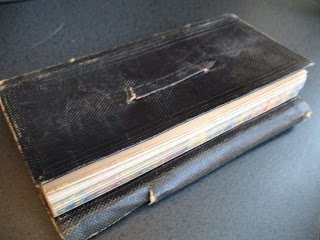I plan to incorporate ideas I presented in these recent blog posts about organizing and culling photographs to get us started and to get people thinking:
Organizing Family Photos: Getting Over the Hump
Culling Family Photographs
Response to Culling Photographs
I want to add some additional points:
Very Basic Preservation – To help ensure that your photographs last a long time, use appropriate supplies from companies such as Gaylord, Conservation Resources, Hollinger Metal Edge and University Products. Most fundamentally, avoid PVCs and seek items that pass the P.A.T. This rating tells us that items have been tested to determine their suitability for storing images and that they do not contain chemical additives or coatings that can harm photographs. I've said this before in earlier posts, but it is worth repeating. I recommend that people consider albums versus boxes. Both can be appropriate for long term storage and it becomes mostly an expense and time issue. Do not feel that you need to create beautiful albums or scrapbooks for all your materials. Boxes come in many different sizes, are cheaper than albums, and take less effort to fill. You can stand images upright in boxes or lie them down if they are oversized. I use appropriate plastic enclosures for collections that will be handled by children and adults. I use albums with slipcovers to keep off dust for images I prize most, want to highlight, and want to view with others regularly.
Displaying – I recommend creating duplicates of prints and storing originals away. Use the copies for display. If you must or have a strong desire to use originals, then use preservation safe mat board and framing techniques with UV filtering glass. Be aware that the type of ink and paper used to create the image, the climate of your home, the light that hits the image, and other environmental elements can be factors influencing the longevity of your prints in both storage and on display.
Backing up – Scanning old printed family photographs is an idea gaining popularity and is most useful for giving you better access to your images. Follow points I recommend in earlier articles for organizing your files. Make duplicate digital files in a variety of places. For example, you may keep images on your computer, have some on a separate drive or server in your home or in someone else's home as a disaster planning measure, and keep others online for additional off-site safety. An online site has the added advantage of giving you, friends and family easy access and the ability to sort, print, and otherwise make use of favorite images. Be aware of migrating issues. Keep up with changes in technology, changing your equipment and the formats of your digital files as necessary. Become familiar with accepted standard formats for photos (TIFF files, jpgs and others) and the value of each. Make prints of digital files as desirable for access and as another backup measure, but as I mentioned earlier be aware of the stability of the materials you use.
A thoughtful approach to keeping your photographs is very important to their longevity. I look forward to "Teachable Tuesday" and hope that we can get a good discussion going about caring for personal family photos. What are your thoughts?











